HIMMLER TO HEAD NAZI PROTECTION SQUAD
Munich, Germany · January 20, 1929
On this date in 1929 failed German chicken farmer Heinrich Himmler became Reichsfuehrer-SS Heinrich Himmler. The SS in his title referred to Schutzstaffel, meaning “Protection Squad.” Informally known by its initials, the SS was created after National Socialist (Nazi) party leader Adolf Hitler, himself a Viennese vagrant, set about forming a new bodyguard following his release from prison for having led the abortive 1923 Munich Beer Hall Putsch. (The putsch was Hitler’s harebrained scheme to take control of the Bavarian state government.) With the 28‑year‑old’s appointment to Reichsfuehrer-SS, Himmler’s fate and that of the SS became inextricably linked. Himmler developed and put into practice his eccentric ideological, mystical, and racial theories, bringing in the concept of “racial purity” for membership in the SS, fashioning the SS as the guardian of the Aryan (Nordic) race against “Jewish Bolshevism,” and positioning the SS as the prime security organ of the Nazi Party and protector of the millennial future of the German Reich. “Should we succeed in establishing this Nordic race again from and around Germany,” he said, “then the world will belong to us.” To that end, Himmler gathered around himself some of the vilest ghouls in Hitler’s pantheon of evil, including Reinhard Heydrich, one of the architects of the Final Solution, and Heydrich’s able lieutenant Adolf Eichmann, Gestapo chief of the department of Jewish affairs. From 1,000 strong in 1929, Himmler headed an organization of 200,000 in 1934. That same year a renovated Renaissance castle in North Rhine-Westphalia, Wewelsburg, was turned into the “Reich SS Leadership School,” where the leading cadre of the “General SS” (“Allgemeine-SS”) and the “Armed SS” (“Waffen-SS”) were to engage in rigorous physical training and study pre- and early history, mythology (Himmler adapted the idea of the Grail to create a heathen mystery for the SS), astronomy, and art. Himmler planned to make Wewelsburg the “center of the new world” (“Zentrum der neuen Welt”) following the “final victory.” When the “final victory” failed to materialize, Himmler ordered the SS to destroy the Wewelsburg, which it did on March 31, 1945, three days before a unit of the U.S. Army Third Armored Division seized the grounds.
![]()
[amazon_carousel widget_type=”ASINList” width=”600″ height=”200″ title=”Recommended Reading” market_place=”US” shuffle_products=”False” show_border=”False” asin=”0375708227,078583012X,019966921X,0786887737,0807846759,0199651744,0300151276,0967044308,1780965982,0141390123″ /]
Reichsfuehrer-SS Heinrich Himmler: The Second Power in Nazi Germany
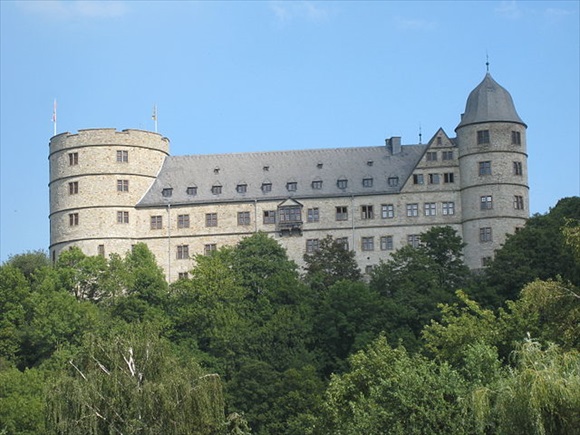 |
Above: Wewelsburg Castle, built between 1603 and 1609 in the northeast of North Rhine-Westphalia, was the planned site of Himmler’s “Reich SS Leadership School” (Reichsführerschule SS). Actual instruction never took place there. Instead, the castle was transformed into an isolated central meeting place for the highest-ranking SS officers. Today the castle serves as a youth hostel, one of the largest in Germany. Photo taken in 2010.
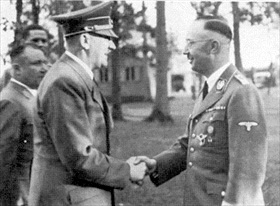 | 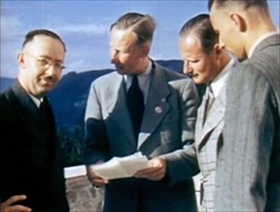 |
Left: Head of the SS from 1929 to 1945 and chief of the Gestapo (secret state police) from 1934 to 1945, “der treue Heinrich” (the loyal Heinrich) was second to Hitler as the most powerful man in Nazi Germany. From 1943 to 1945 Himmler held another post, Minister of the Interior; in this position he was one of the persons most directly responsible for the Holocaust.
![]()
Right: Himmler with Reinhard Heydrich (holding sheets of paper) at Hitler’s Bavarian retreat on the Obersalzberg, 1939. Heydrich, ruthless head of the Reich Security Head Office (RSHA), worked under Himmler. In July 1941 Reichsmarschall Hermann Goering ordered the conscienceless and more-than-willing Heydrich to prepare the “final solution”—the extermination of all Jews in Europe.
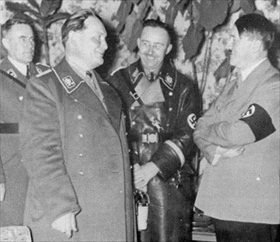 | 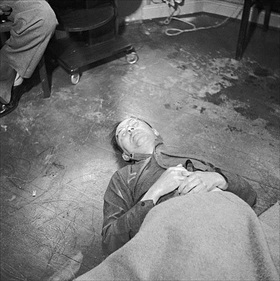 |
Left: On the day of the invasion of Poland, September 1, 1939, Hitler tapped Goering, here seen with Himmler, to be his successor. From 1942 onwards Goering largely withdrew from Nazi Germany’s military and political scene when the Luftwaffe, which he headed, stumbled on both the Western and Eastern fronts.
![]()
Right: Himmler’s body on the floor of British 2nd Army HQ after his suicide on May 23, 1945, during a routine interrogation. Two days earlier Himmler, a fugitive using an alias, had been detained at a British checkpoint. During his interrogation Himmler revealed his true identity.
Occult History of the Third Reich: Heinrich Himmler, SS Mystic
![]()

 History buffs, there is good news! The Daily Chronicles of World War II is now available as an ebook for $4.99 on Amazon.com. Containing a year’s worth of dated entries from this website, the ebook brings the story of this tumultuous era to life in a compelling, authoritative, and succinct manner. Featuring inventive navigation aids, the ebook enables readers to instantly move forward or backward by month and date to different dated entries. Simple and elegant! Click
History buffs, there is good news! The Daily Chronicles of World War II is now available as an ebook for $4.99 on Amazon.com. Containing a year’s worth of dated entries from this website, the ebook brings the story of this tumultuous era to life in a compelling, authoritative, and succinct manner. Featuring inventive navigation aids, the ebook enables readers to instantly move forward or backward by month and date to different dated entries. Simple and elegant! Click 











